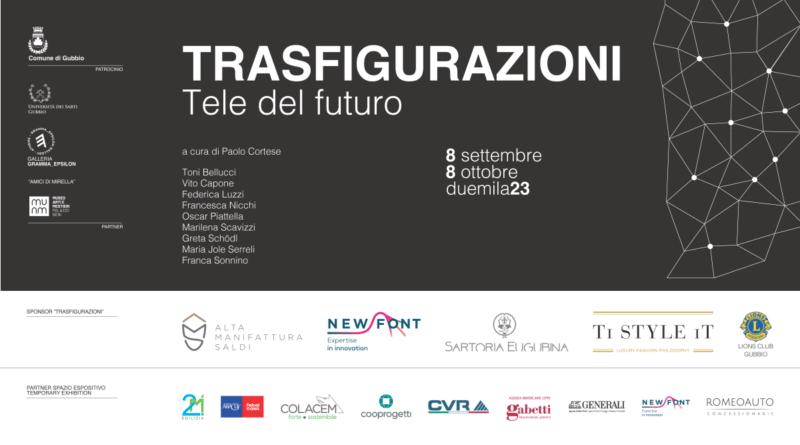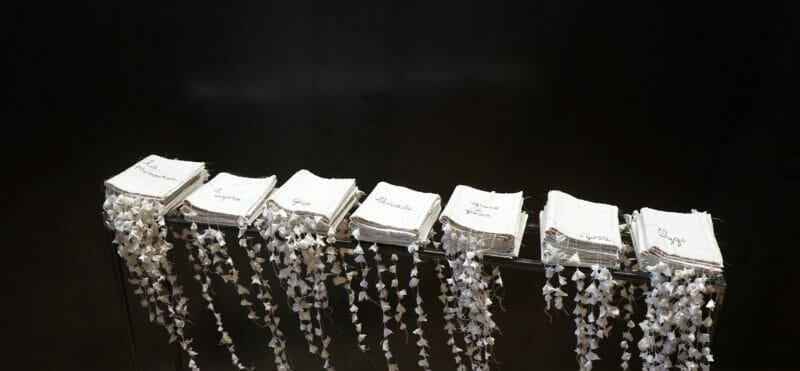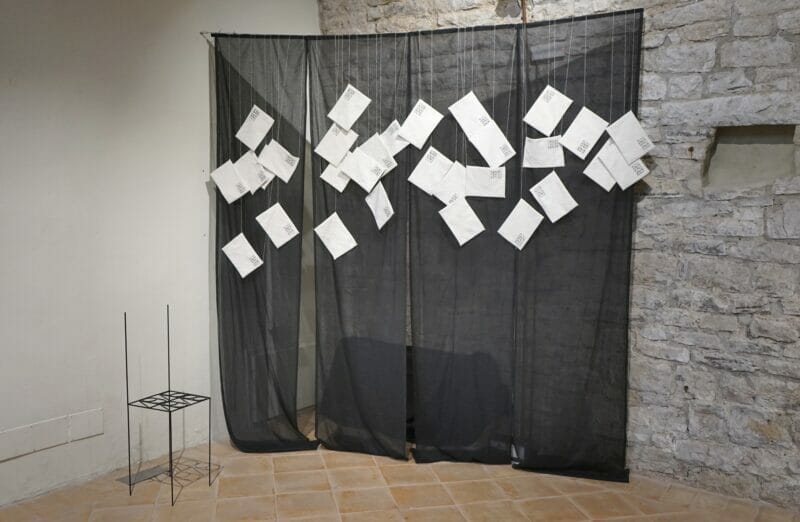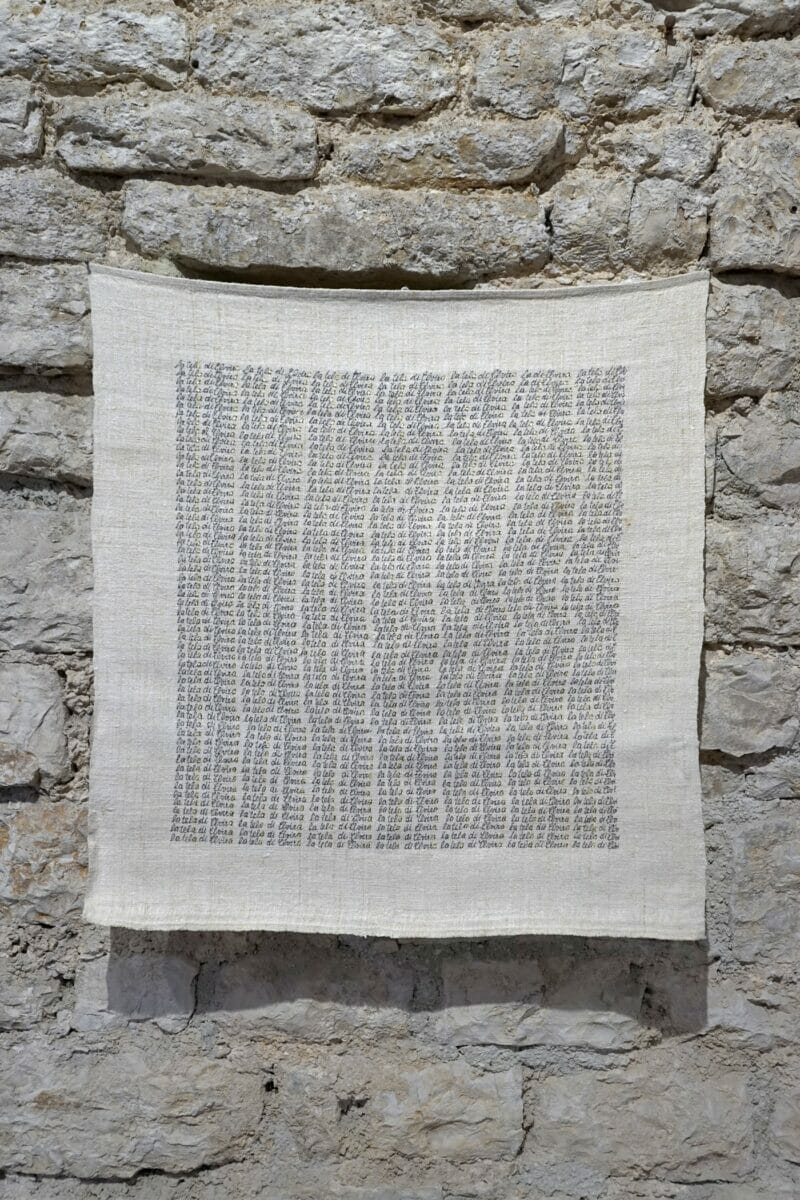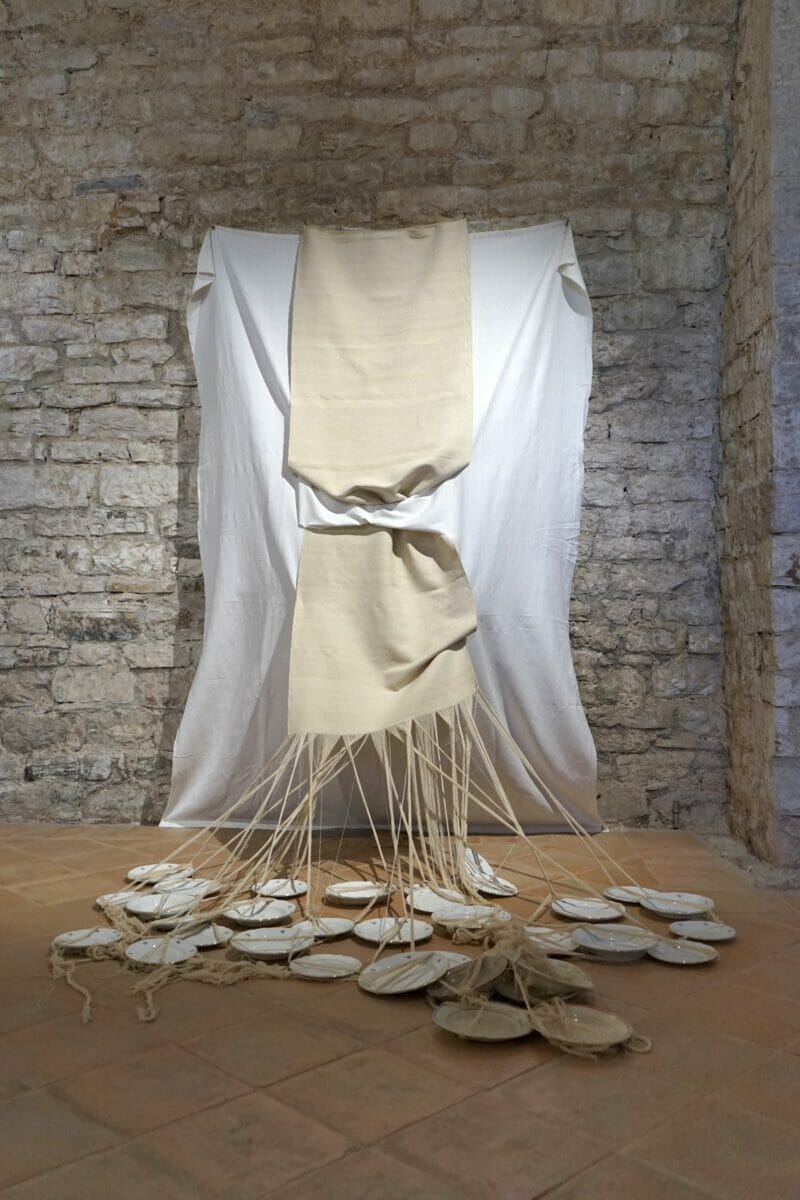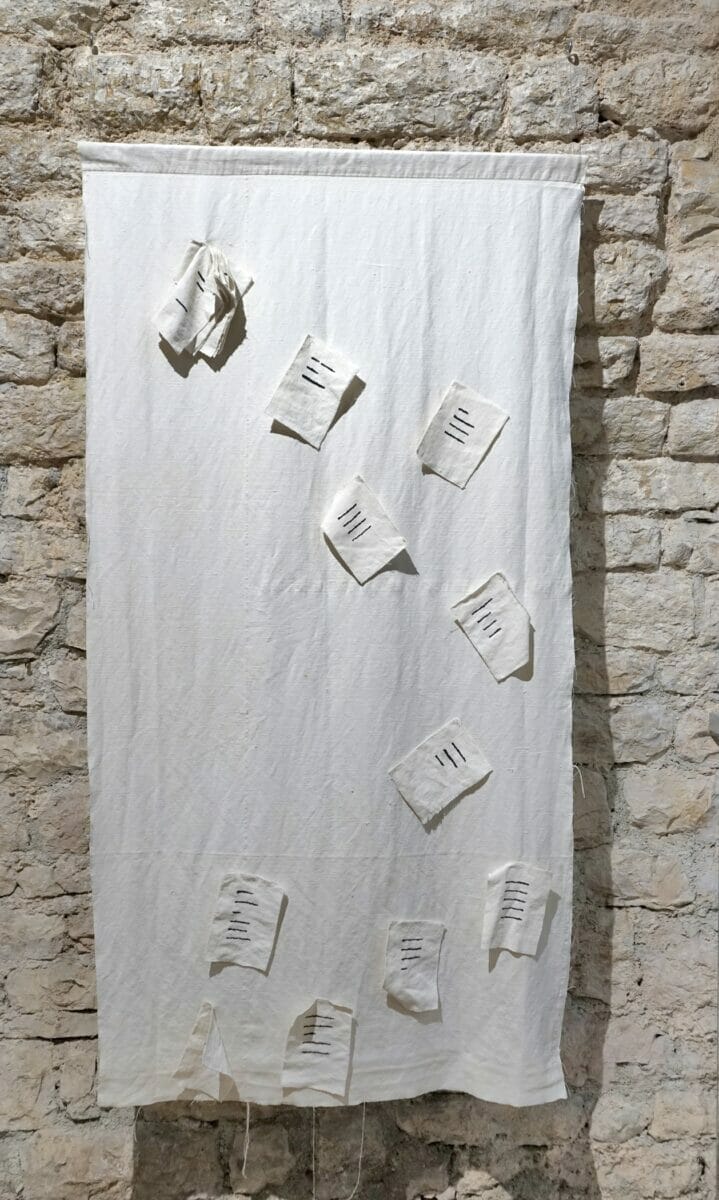TRASFIGURAZIONI. Tele del futuro
8 September-8 October 2023
Opening: 8 September 2023 at 6 p.m.
Venue: Gubbio, MUAM Museum of Arts and Crafts
Curated by: Paolo Cortese
Artists: Toni Bellucci, Vito Capone, Federica Luzzi, Francesca Nicchi, Oscar Piattella, Marilena Scavizzi, Greta Schödl, Maria Jole Serreli, Franca Sonnino
Patronage: Municipality of Gubbio – Department of Culture
Partners: University of Gubbio; Gramma_Epsilon Gallery, Athens; Amici di Mirella, Gubbio
From 8 September to 8 October, the exhibition Trasfigurazioni. Canvases of the future, curated by Paolo Cortese.
Craftsmanship and contemporary art, the talent of the past meeting the passion and solutions of the present. Fernando Sebastiani‘s donation of precious original linen and cotton cloths made by his grandmother Elvira between 1920 and 1950 with a domestic loom takes the form of a unique cultural encounter.
The story of Elvira Sollevanti in Sebastiani, born in Gubbio at the end of the 19th century, is intertwined with the history of an Italy that goes through two world wars in the space of a few decades. Like many other women, Elvira does not resign herself to the news that her husband will never return home and continues to work at her loom, like a modern-day Penelope, weaving sheets, pillowcases and towels, confident that one day the door will open to reunite her with her beloved husband who escaped the war. A story from a novel, life is harder, especially that of those days. And the happy ending is not part of the tale. In the face of pain and history, however, these artefacts, splendid in their simplicity, endure. Which today, thanks to the intervention of invited artists, can continue to tell visitors a unique love story with the extraordinary scenery of Gubbio acting as a link between the two centuries.
The invited artists interpreted, each according to the specificity of his or her language, this love story that was, however, only the incipit for a story yet to be written. The total freedom with which they washed the sheets allowed them to create highly original works in which the memory of the past is composed in a new vision, materialised through an individual creative process. In this sense, the intentional heterogeneity with which the artists were selected should also be understood.
One could say that the female element in this exhibition is prevalent not only because of the connection with Elvira Sollevanti, but also because of the nine invited, six are female artists. Vito Capone and Toni Bellucci share a significant friendship with Mirella Bentivoglio, a curator and artist who is one of the leading representatives of the verbo-visual and book object sector. And it was precisely in Gubbio that Bentivoglio realised in 1976 the first intervention in the area dedicated to women: the “Lapide all’adultera lapidata”, better known as “Ovo di Gubbio”, recently returned to the city after a long restoration.
From different generations the artists involved have in common the Fiber element, declined through very different codes and poetics.
A special tribute, curated by Alberto Mazzacchera, was dedicated to Oscar Piattella, who recently passed away. The artist is virtually present thanks to the precious contribution of the Oscar Piattella Archive represented by its president Fernando Barbetti.
Toni Bellucci was born in Gubbio in 1953. Very young, he was invited by Enrico Crispolti to the Gubbio Biennial in 1976, during which he met Mirella Bentivoglio. The predisposition for research and experimentation that will be a constant in his work was immediately apparent in him. As a sculptor, Bellucci moves with ease using the most disparate materials: from iron to wood and stone, but he loves to put himself to the test by experimenting with resins and oxides and by using natural pigments to create works that, although strongly contemporary, can express the ancient roots of his land, the medieval mystical culture, the Renaissance revolution and alchemic knowledge.
Vito Capone, a Roman artist, Apulian by adoption, born in 1935, after starting out as a painter, has dedicated himself since the early 1980s to researching matter in all its expressive possibilities and its ability to be transformed into something else. For almost 50 years now, his attention has been turned to paper on which he skilfully intervenes with a suitably modified cutter, making micro-cuts, incisions, abrasions, lifting flaps, and inserting tesserae so as to originate a universe that, on careful reading, reveals itself as extraordinary and imaginative despite the simplicity of the single support and the almost prevalent monochrome. Since the 1960s he has exhibited regularly in Italy and abroad in galleries and institutional venues, participating in the 2011 Venice Biennale, among others. He has taught for over thirty years
Federica Luzzi was born in Rome in 1970. She graduated in Literature with an art historical focus and specialised in both traditional and experimental techniques of knotting and vertical loom tapestry in Poland, Hungary, Belgium and Romania. Over the last 10 years, she has created a large cycle of works whose title ‘Shell’ already announces how dense it is with meaning and possibility. In fact, this word, which in English has a much broader meaning than the Italian translation ‘conchiglia’ (shell), refers to a research that ranges from the relationship between inside/outside, to emptiness/fullness, life/death, permanent/momentary and so on. These works, made with thread and monochrome colours, have a minimal and discreet charm and in their apparent simplicity refer to an aesthetic typical of Japan, a country with which the artist has strong ties.
Francesca Nicchi, born in Cosenza in 1967, prefers textiles in all their forms. For her artworks she uses materials and techniques that somehow evoke the feminine universe; fabrics, buttons, threads and tangles that she combines to create three-dimensional works that are often anthropomorphic. Her creations, even when small in size, emanate a strong communicative impact, almost as if to call attention to the need for both oral and written narrative. Alongside artistic production in the strict sense of the word, Nicchi pursues projects related to handicrafts, illustration and is involved in Art Therapy.
Marilena Scavizzi is a versatile artist from Gubbio, whose work ranges from Fiberart to ceramics and engraving, a subject she taught for many years at the Piero Vannucci Academy of Fine Arts in Perugia. And it is precisely from experimenting with the use of wood and linoleum matrices born to print on paper that her journey begins. The search for effects of softness, apparently in contrast to the rigidity of the plates, was the challenge the artist took on in order to “eliminate something too rigid and scholastic”. Scavizzi has experimented with different techniques, tools and media over the years, obtaining surprising results; particularly interesting are her tapestries that interpret such an ancient tool as the loom in a contemporary and original way.
Greta Schödl was born in Hollabrunn, Austria, in 1929 and has lived and worked in Bologna for over 60 years. Considered one of the most important artists of visual poetry, she uses paper or textile media where she literally weaves her words. The emphasis of her work, however, is not limited to the verbal element but rather to its arrangement within a space she has defined, and the relationship she creates with the medium used. The composition provides the backdrop for a rhythm that Schödl imparts through small gold sign interventions, which give the whole a strong emotional tension.
Maria Jole Serreli (Rome 1975) is a multidisciplinary artist who also expresses her artistic vision in poetry and performance art. Living and working in Sardinia, she is often inspired by the archaic and traditional heritage of her territory. Serreli’s intent is to re-evaluate and pay homage to the concept of domestic life by giving value to the simple objects linked to everyday life, reawakening the memories that unite us to our dearest affections. She is one of the leading young exponents of fibre art. Her ceramic works are interesting, where her experimentation with techniques and materials of oriental origin is supported by a precise formal structure that allows her to achieve harmonious and balanced results.
Franca Sonnino (Rome 1932) began her artistic career in the early 1970s, devoting herself to painting under the guidance of Maria Lai. The works of those years are dense grids, multitudes of painted lines, whose profound impulse stems from intimate poetic theorems rather than Euclidean models. Thread, already present as the subject of her paintings, soon became a privileged medium in Sonnino’s art, definitively replacing the paintbrush from the late 1970s. Using cotton thread twisted around wire, the artist outlines the contours of objects in space, simulating the third dimension. He has thus profiled phantom bookcases provocatively arranged on walls, with rhythmic play of shadows on air books. He also knits loose volumes and detached sheets, cryptically alluding with the wire to writing.
Oscar Piattella (Pesaro 1932-Urbino 2023) was one of the protagonists of the Italian artistic renewal of the 1950s, together with Arnaldo and Giò Pomodoro, Giuliano Vangi, Loreno Sguanci and Nanni Valentini. After a figurative beginning, his attention turned towards informal research. From the second half of the 1950s he began to exhibit regularly in Italy and abroad in galleries and institutional venues, coming into contact with artists such as Alberto Burri, Lucio Fontana and Enrico Castellani. In 1958, Franco Russoli, director of the Pinacoteca di Brera, curated a solo exhibition of his work at the Galleria L’Ariete in Milan. His work unfolded over the following decades in an autonomous and solitary manner, but he was always attentive to contemporary European research, which Piattella looked at with great interest.
Located in the historic Palazzo Beni, the Gubbio Museum of Arts and Crafts, MUAM, represents a place where Gubbio’s roots are preserved, through the narration of the most ancient traditions linked to the arts and crafts that, over the centuries, have characterised the city and its territory.
The University of Gubbio Tailors, a partner in the event, has its origins in the 14th century with the birth of the Guilds of Arts and Crafts. In fact, the ‘Statutum’ of the Municipality of Gubbio of 1338, includes the ‘Ars Sartorum’ among the arts regulated by specific statutes.
On the contrary, the Gramma_Epsilon gallery in Athens, another partner of the event, is very young and is dedicated exclusively to women artists, carrying on the work started by Mirella Bentivoglio in the early 1970s to promote female art, with a particular focus on that linked to the verbo-visual sector, the book object, fibreart and more generally to object experimentation.
The Amici di Mirella (Friends of Mirella) are a group of friends linked to the figure of Mirella Bentivoglio who in 2022 contributed to the relocation of the Ovo di Gubbio in its original location.
INFO
Gubbio, MUAM Museo delle Arti e dei Mestieri
Via Cavour, 7 06024 Gubbio (PG)
tel. +39 3930574248
Hours: 10-12.15 a.m. – 3.30-6.30 p.m. (please consult website)
Tickets: 3 € reduced entrance Temporary Exhibition (exhibition “Trasfigurazioni. Tele del futuro”) – 5 € full entrance Temporary Exhibition + MUAM permanent exhibition.
info@muam.it
muam.it
